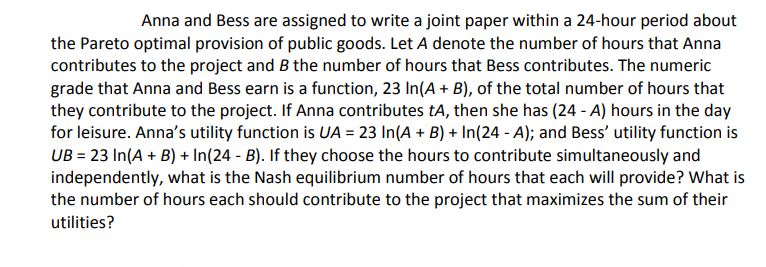Anna and Bess are assigned to write a joint paper within a 24-hour period about the Pareto optimal provision of public goods. Let A denote the number of hours that Anna contributes to the project and B the number of hours that Bess contributes. The numeric grade that Anna and Bess earn is a function, 23 In(A + B), of the total number of hours that they contribute to the project. If Anna contributes tA, then she has (24 - A) hours in the day for leisure. Anna's utility function is UA = 23 In(A + B) + In(24 - A); and Bess' utility function is UB = 23 In(A + B) + In(24 - B). If they choose the hours to contribute simultaneously and independently, what is the Nash equilibrium number of hours that each will provide? What is the number of hours each should contribute to the project that maximizes the sum of their utilities?
Anna and Bess are assigned to write a joint paper within a 24-hour period about the Pareto optimal provision of public goods. Let A denote the number of hours that Anna contributes to the project and B the number of hours that Bess contributes. The numeric grade that Anna and Bess earn is a function, 23 In(A + B), of the total number of hours that they contribute to the project. If Anna contributes tA, then she has (24 - A) hours in the day for leisure. Anna's utility function is UA = 23 In(A + B) + In(24 - A); and Bess' utility function is UB = 23 In(A + B) + In(24 - B). If they choose the hours to contribute simultaneously and independently, what is the Nash equilibrium number of hours that each will provide? What is the number of hours each should contribute to the project that maximizes the sum of their utilities?
Chapter19: Externalities And Public Goods
Section: Chapter Questions
Problem 19.2P
Related questions
Question

Transcribed Image Text:Anna and Bess are assigned to write a joint paper within a 24-hour period about
the Pareto optimal provision of public goods. Let A denote the number of hours that Anna
contributes to the project and B the number of hours that Bess contributes. The numeric
grade that Anna and Bess earn is a function, 23 In(A + B), of the total number of hours that
they contribute to the project. If Anna contributes tA, then she has (24 - A) hours in the day
for leisure. Anna's utility function is UA = 23 In(A + B) + In(24 - A); and Bess' utility function is
UB = 23 In(A + B) + In(24 - B). If they choose the hours to contribute simultaneously and
independently, what is the Nash equilibrium number of hours that each will provide? What is
the number of hours each should contribute to the project that maximizes the sum of their
utilities?
Expert Solution
This question has been solved!
Explore an expertly crafted, step-by-step solution for a thorough understanding of key concepts.
This is a popular solution!
Trending now
This is a popular solution!
Step by step
Solved in 3 steps with 2 images

Knowledge Booster
Learn more about
Need a deep-dive on the concept behind this application? Look no further. Learn more about this topic, economics and related others by exploring similar questions and additional content below.Recommended textbooks for you


Principles of Microeconomics
Economics
ISBN:
9781305156050
Author:
N. Gregory Mankiw
Publisher:
Cengage Learning


Principles of Microeconomics
Economics
ISBN:
9781305156050
Author:
N. Gregory Mankiw
Publisher:
Cengage Learning